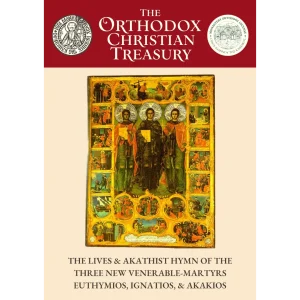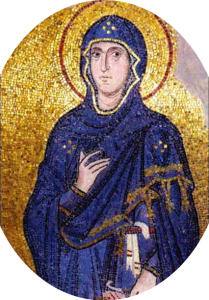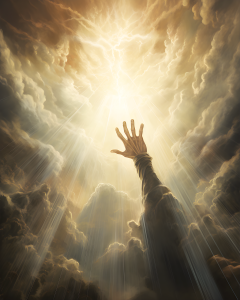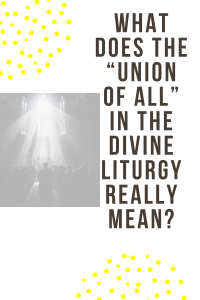THE ORTHODOX UNDER THE OTTOMAN YOKE
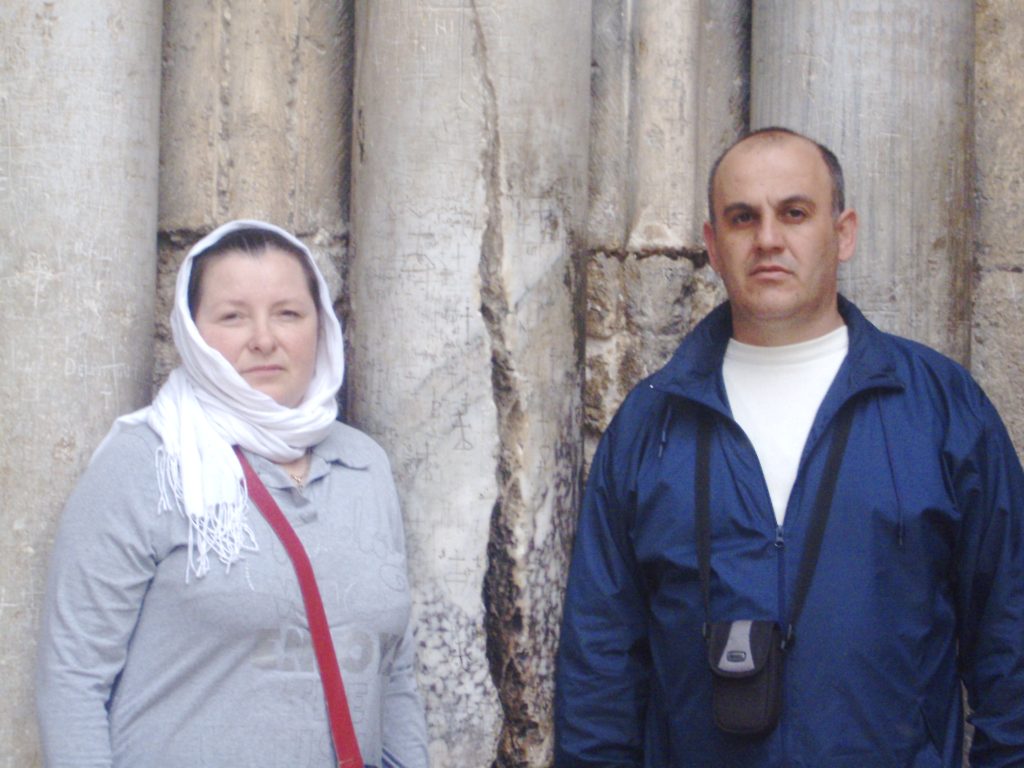
The Column of the Holy Yard of the Holy Sepulcher
by Vladimir Moss
“On Tuesday, 29 May, 1453,” writes Sir Steven Runciman, “an old story was ended. The last heir of Constantine the Great lay dead on the battlefield; and an infidel Sultan had entered in triumph into the city which Constantine had founded to be the capital of the Christian Empire. There was no longer an Emperor reigning in the Sacred Palace to symbolize to the Faithful of the East the majesty and authority of Almighty God.[1] The Church of Constantinople, for more than a thousand years the partner of the Orthodox State, became the Church of a subject people, dependent on the whims of a Muslim master. Its operation, its outlook and its whole way of life had abruptly to be changed.
“It was a fundamental change; and yet it was not quite as complete as it might seem at first sight. For centuries past the historic Patriarchates of the East, Alexandria, Antioch and Jerusalem, had been, but for brief interludes, under the political sway of Muslim authorities. Ever since the Turks had first occupied parts of Asia Minor in the eleventh century congregations belonging to the Patriarchate of Constantinople had been living under Muslim rule. In recent decades the rapid spread of the Ottoman Empire, in Europe as well as in Asia, had added to their number, till by 1453 the majority of the Patriarch’s flock dwelt in the Sultan’s dominion. There were also many Greek islands which had been for some time under Latin masters and which were to remain under them for some time to come. Though the Genoese were to lose the greater part of their Greek colonies immediately after 1453, they retained the island of Chios till 1566. The Venetians held fortresses in the Peloponnese and a number of Aegean islands till well into the sixteenth century; they held Crete till 1669 and Tinos till 1715. Cyprus, still an independent kingdom at the time of the fall of Constantinople, was in Venetian hands from 1487 to 1570. The Italian Duchy of the Archipelago lasted till 1500, when the Turks imposed a Jewish vassal Duke. The Knight of St. John held Rhodes till 1522. The Ionian islands off the west coast of Greece never passed under Turkish rule. They remained in Venetian hands until the end of the eighteenth century, when they were taken over by the French and then passed to the British, who ceded them to the Kingdom of Greece in 1864. Thus there were a few provinces where the Patriarch’s authority could not always be implemented. Nevertheless, from the narrow viewpoint of ecclesiastical control and discipline the Patriarchate gained from the conquest because the vast bulk of its territory was reunited under one lay power.
“But the lay power was infidel. So long as the Christian Empire lasted at Constantinople, Church and State were still integrated there in one holy realm. The Emperor might in fact be politically feeble, but in theory he was still the transcendent head of the Christian Oecumene, the representative of God before the people and the people before God. Now the Church was divorced from the State. It became an association of second-class citizens. Here again, as the only association that these second-class citizens were permitted to organize, its powers of discipline over its congregations were enhanced. But it lacked the ultimate sanction of freedom.
“The Conquering Sultan was well aware of the problems that faced the Church; and he was not hostile to its well-being. He had been a truculent enemy until Constantinople was conquered; and the conquest had been achieved by bloodthirsty and destructive violence. But, having conquered, he was not ungenerous. He had Greek blood in his veins. He was well read and deeply interested in Greek learning. He was proud to see himself as the heir of the Caesars and was ready to shoulder the religious responsibilities of his predecessors, so far as his own religion permitted. As a pious Muslim he could not allow the Christians any part in the higher council of his Empire. But he wished them to enjoy peace and prosperity and to be content with his government and an asset to it.
“His first duty to the Christians was to establish the new pattern for their administration. His solution followed lines traditional in Muslim dominions. Muslim rulers had long treated religious minorities within their dominions as millets, or nations, allowing them to govern their own affairs according to their own laws and customs, and making the religious head of the sect responsible for its administration and its good behaviour towards the paramount power. This was the manner according to which the Christians in the Caliphate had been ruled, amongst them the congregations of the Eastern Orthodox Patriarchates. The system was now extended to include the Orthodox Patriarchate of Constantinople. For practical purposes it had already been followed in the districts of the Patriarchate that were within the Turkish dominions. Where their lay officials had been ejected or had fled the Christians had naturally looked to their hierarchs to negotiate with the conquerors on their behalf; and it was the hierarchs who had carried out the day-to-day administration of their flocks as best they could. But hitherto for them, as also for the Orthodox Patriarchs of the East, there had been in Constantinople an Orthodox Emperor to whom they owed ultimate allegiance and whose duty it was to protect them, even if they could no longer administer them. In recent years the protection that he was able to provide, in his impotent and impoverished state, had been merely nominal; but nevertheless it gave them prestige; it raised them above the heretic Churches, such as the Copts and the Jacobites, who had no lay protector and were entirely the servants of the Muslim monarch. But now, with the Emperor gone, even this nominal protection disappeared. The Orthodox were reduced to the state of the heretic Churches, in theory at least. In practice they were better off; for they formed the largest, the richest and the best-educated Christian community in the Sultan’s dominions; and Sultan Mehmet with his sense of history was inclined to pay them special attention.
“The Sultan was well aware, also, that the Greeks would be of value to his Empire. The Turks would provide him with his governors and his soldiers; but they were not adept at commerce or industry; few of them were good seamen; and even in the countryside they tended to prefer a pastoral to an agricultural life. For the economy of the Empire the co-operation of the Greeks was essential. The Sultan saw no reason why they should not live within his dominions in amity with the Turks, so long as their own rights were assured and so long as they realized that he was their overlord.
“If the Greek milletwas to be organized, the first task was to provide it with a head. Sultan Mehmet knew well of the difficulties that the attempt to force union with Rome had produced in the Greek Church; and, after the conquest, he soon satisfied himself that the average Greek considered the Patriarchal throne to be vacant. The Patriarch Gregory Mammas was held to have abdicated when he fled to Italy in 1451. A new Patriarch must be found. After making some inquiries Mehmet decided that he should be George Scholarius, now known as the monk Gennadius. Gennadius was not only the most eminent scholar living in Constantinople at the time of the conquest. He was everywhere respected for his unflinching probity; and he had been the leader of the anti-Unionist, anti-Western party within the Church. He could be relied upon not to intrigue with the West. Within a month of the conquest the Sultan sent officials to bring Gennadius to his presence. He could not at first be found. Eventually it was discovered that he had been taken prisoner at the time of the fall of the city and had passed into the possession of a rich Turk of Adrianople, who was deeply impressed by his learning and was treating him with honours seldom accorded to a slave. He was redeemed from his buyer and was conveyed honourably to Constantinople and led before the Sultan. Mehmet persuaded him to accept the Patriarchal throne; and together they worked out the terms for the constitution to be granted to the Orthodox. The main lines were probably arranged before the Sultan left the conquered city for Adrianople at the end of June, though six months elapsed before Gennadius actually assumed the Patriarchate.
“The enthronization took place in January 1454, when the Sultan returned to Constantinople. Mehmet was determined to play in so far as his religion permitted the role played in the past by the Christian Emperor. We know nothing about the necessary meeting of the Holy Synod; but presumably it was formed by such metropolitans as could be gathered together and it was their task to declare the Patriarchate vacant and, on the Sultan’s recommendation, to elect Gennadius to fill it. Then, on 6 January, Gennadius was received in audience by the Sultan, who handed him the insignia of his office, the robes, the pastoral staff and the pectoral cross. The original cross was lost. Whether Gregory Mammas had taken it with him when he fled to Rome or whether it disappeared during the sack of the city is unknown. So Mehmet himself presented a new cross, made of silver-gilt. As he invested the Patriarch he uttered the formula: ‘Be Patriarch, with good fortune, and be assured of our friendship, keeping all the privileges that the Patriarchs before you enjoyed.’ As Santa Sophia had already been converted into a mosque, Gennadius was led to the Church of the Holy Apostles. There the Metropolitan of Heraclea, whose traditional duty it was to consecrate, performed the rite of consecration and enthronization. The Patriarch then emerged and, mounted on a magnificent horse which the Sultan had presented to him, rode in procession round the city before returning to take up his residence in the precincts of the Holy Apostles. He had also received from the Sultan a handsome gift of gold.
“It is unlikely that the new constitution was ever written down. The general lines along which a Christian milletin Muslim territory was administered were well enough known not to need a general restatement. The Imperial berat which gave the Sultan’s approval of every appointment to episcopal office usually stated the duties of the incumbent, following the traditional customs. We only hear of two specific documents issued by the Conquering Sultan. According to the historian Phrantzes, who was at that time a captive of the Turks and was in a position to know about it, Mehmet handed to Gennadius a firman which he had signed, giving to the Patriarch personal inviolability, exemption from paying taxes, freedom of movement, security from deposition, and the right to transmit these privileges to his successors. There is no reason for doubting this. It is indeed probable that the Sultan would give to the Patriarch some written guarantee about his position. It should, however, be noted that the freedom from deposition was not held to interfere with the traditional right of the Holy Synod to depose a Patriarch if his election was held to have been uncanonical or if he were demonstrably unfitted for the office. Patriarchal chroniclers writing nearly a century later claimed that the Sultan had signed another document in which he promised that the customs of the Church with regard to marriage and burial should be legally sanctioned, that Easter should be celebrated as a feast and the Christians should have freedom of movement during the three Easter feast-days, and that no more churches should be converted into mosques. Unfortunately, when the last point was disregarded by later Sultans, the Church authorities could not produce the document, which they said, no doubt correctly, had been destroyed in a fire at the Patriarchate. But, as we shall see, they were able to produce evidence to substantiate their claim.
“Whatever might have been written down, it was generally accepted that the Patriarch, in conjunction with the Holy Synod, had complete control over the whole ecclesiastical organization, the bishops and all churches and monasteries and their possessions. Though the Sultan’s government had to confirm episcopal appointments, no bishop could be appointed or dismissed except on the recommendation of the Patriarch and the Holy Synod. The Patriarchal law-courts alone had penal jurisdiction over the clergy; the Turkish authorities could not arrest or judge anyone of episcopal rank without the permission of the Patriarch. He also, in conjunction with the Holy Synod, had control over all matters of dogma. His control was almost as complete over the Orthodox laity. He was the Ethnarch, the ruler of the millet[or millet-bashi]. The Patriarchal courts had full jurisdiction over all affairs concerning the Orthodox which had a religious connotation, that is, marriages, divorce, the guardianship of minors, and testaments and successions. They were entitled to try any commercial case if both disputants were Orthodox. Though the Christian laity were heavily taxed, the clergy were free from paying the taxes, though on occasions they might of their own consent agree to pay special taxes; and it was difficult for the Sultan to exert pressure to secure this consent. The Patriarch could tax the Orthodox on his own authority to raise money for the needs of the Church. Complaints against the Patriarch could only be heard by the Holy Synod, and only if it agreed unanimously to listen to them. The Patriarch could call in the Turkish authorities to see that his wishes were carried out by his flock. In return for all this, the Patriarch was responsible for the orderly and loyal behaviour of his flock towards the ruling authorities and for ensuring that the taxes of the head-man of the local commune, who was responsible for keeping the registers. But, if there was any difficulty over the collection, the Government could ask the Church to punish recalcitrant with a sentence of excommunication.
“The Patriarchal courts administered justice according to the canon law of the Byzantines and according to Byzantine civil and customary law. Customary law grew rapidly in volume, owing to changed circumstances for which the codified law did not allow, and which varied from place to place. In civil cases the judgement was in the nature of an arbitration award. If either party were dissatisfied with it he could have recourse to Turkish courts; and if either party insisted, the case could be brought before the Turkish courts in the first instance. This was seldom done, as the Turkish courts were slow, expensive and often corrupt, and heard cases according to Koranic law. The Patriarchal courts were considered to be remarkably free from corruption, though rich Greeks on whose financial support the Church depended could undoubtedly exercise some influence. A feature of the courts was that a statement taken on oath counted as valid evidence; and so seriously were oaths regarded that this was seldom abused. Criminal offences, such as treason, murder, theft or riot, were reserved to the Turkish courts, unless the accused was a priest…
“In theory, the structure of the Great Church, as the Greeks called the Patriarchal organization, even though the Great Church itself, Saint Sophia, was no longer a Christian temple, was not altered by the conquest. The Patriarch was still officially elected by the Holy Synod consisting of the metropolitans, and the election was confirmed by the lay suzerain. As in Byzantine times the lay suzerain almost invariably indicated the candidate whom he wished to be elected; and the old custom of submitting three names to him, which had fallen into disuse in late Byzantine times, was formally abolished. But the increased administrative duties of the Patriarchate inevitably led to changes. The Holy Synod had originally consisted of the metropolitans alone, though the high officials of the Patriarchate seem sometimes to have attended its meetings. Soon after the conquest they were officially added to it; and there was a general enhancement of the constitutional importance of the Synod. The Patriarch became little more than its president. In theory this was a reaffirmation of the democratic principles of the Church. In practice it that, while a strong and popular Patriarch would meet with no difficulties, Patriarchal authority could always be undermined. Turkish officials, without seeming openly to interfere in the internal affairs of the Church, could exercise what influence they desired through intrigues with individual members of the Synod…”[2]
“In effect,” writes Norman Russell, “the patriarch was a minister for Christian affairs in the Ottoman scheme of things, invested with just sufficient power to ensure that the people paid the taxes to the Ottoman government. By the end of the eighteenth century it is estimated that he governed approximately one quarter of the population of the empire, some thirteen million Orthodox.” [3]
This weakness in the new system soon made itself felt, together with the increased influence of laymen recruited to help the Patriarch with his increased administrative burden.
The root of the problem was that each new patriarch had to pay for the beratauthorizing him to carry out his office, and the Turks were constantly increasing the price, which meant that the patriarch had to ask his clergy for money, and they in turn asked the people…The only Christians who could pay these bribes were the Phanariots, loyal Greek Christian officials, rich merchants who had risen to power in the sixteenth century in Constantinople, who called themselves the “Archontes” of the Greek nation, and who were called by others “Phanariots” because they came from the Phanar, the Christian quarter of Constantinople where the Patriarchate was based.
“They obtained for their sons positions in the Patriarchal court; and one by one the high offices of the Great Church passed into lay hands. Their members did not enter the Church itself. That was considered to be beneath their dignity. The bishops and the Patriarch himself continued to be drawn mainly from bright boys of humbler classes who had risen through intelligence and merit. But by the end of the seventeenth century the Phanariot families, as they were usually called, dominated the central organization of the Church. They could not control it completely. Occasionally, as in the case of Patriarch Cyril V, they would be overridden by public opinion. But the Patriarchate could not do without them; for they were in a position both to pay its debts and to intrigue in its favour at the Sublime Porte…
“While they sought to increase their riches and through their riches to obtain influence at first the Patriarch’s and then the Sultan’s courts, they dreamed that the influence might ultimately be used to recreate the Empire of Byzantium…”[4]
The most famous of the Phanariots was Alexander Mavrocordatos, who became Grand Dragoman of the Ottoman Empire at the age of thirty-one, remaining in that post for twenty-five years, “with a brief interval early in 1684, when he was cast into prison as one of the scapegoats for the Turkish failure before Vienna. His mother, who joined him in prison, died soon after their release, in August 1684. Alexander was soon reinstated. In 1688 he led an Ottoman embassy to Vienna. In 1698 a still higher post was created for him. He became Exaporite, Minister of the Secrets, Private Secretary to the Sultan, with the title of Prince and Illustrious Highness. In 1698 he was the chief Turkish delegate at the peace conference of Carlowitz, where the Habsburg Emperor gave him the title of Prince of the Holy Roman Empire. He died in 1709, honoured and immensely rich. His career had opened up new vistas for Greeks of ambition.
“Though none of the later Phanariots quite measured up to Alexander Mavrocordatos’ stature, he set the pattern for them. He was remarkably intelligent and highly educated, and always eager to maintain intellectual contacts with the West. The Jesuits believed him to be a secret Catholic; but his actions scarcely confirmed their belief. He took an active part in the affairs of the Orthodox Church, fighting for its rights. As Grand Dragoman he secured a relaxation of the rules restricting the building of new churches, and he arranged for the transference of many of the Holy Places at Jerusalem from Latin to Greek ownership, in co-operation with the great Patriarch Dositheus of Jerusalem. But he was far from fanatical. He gave strict orders to the Greeks at Jerusalem that they were to welcome and aid Christians of all sects who visited the shrines under their care; and he seems to have believed that it might be possible to reunite the Churches of Christendom on a new philosophical basis, resting on the foundation of the unity of the old Graeco-Roman world. His attitude revealed his Jesuit training. He was a philosopher and an intellectual, eager to be an up-to-date European, with little sympathy with the old apophatic tradition of Orthodoxy. He did much in practice for his Church; but the school of thought that he represented was to add to its problems…”[5]
“Above all,” continues Runciman, “the Phanariots needed the support of the Church in the pursuit of their ultimate political aim. It was no mean aim. The Megali Idea, the Great Idea of the Greeks, can be traced back to days before the Turkish Conquest. It was the idea of the Imperial destiny of the Greek people. Michael VIII Palaeologus expressed it in the speech that he made when he heard that his troops had recaptured Constantinople from the Latins; though he called the Greeks the Romaioi. In later Paleologan times the word Hellene reappeared, but with the conscious intention of connecting Byzantine imperialism with the culture and traditions of ancient Greece. With the spread of the Renaissance a respect for the old Greek civilization had become general. It was natural that the Greeks, in the midst of their political disasters, should wish to benefit from it. They might be slaves now to the Turks, but they were of the great race that had civilized Europe. It must be their destiny to rise again. The Phanariots tried to combine the nationalistic force of Hellenism in a passionate if illogical alliance with the oecumenical traditions of Byzantium and the Orthodox Church. They worked for a restored Byzantium, a New Rome that should be Greek, a new centre of Greek civilization that should embrace the Orthodox world. The spirit behind the Great Idea was a mixture of neo-Byzantinism and an acute sense of race. But, with the trend of the modern world the nationalism began to dominate the oecumenicity. George Scholarius Gennadius had, perhaps unconsciously, foreseen the danger when he answered a question about his nationality by saying that he would not call himself a Hellene though he was a Hellene by race, nor a Byzantine though he had been born at Byzantium, but, rather, a Christian, that is, an Orthodox. For, if the Orthodox Church was to retain its spiritual force, it must remain oecumenical. It must not become a purely Greek Church….”[6]
The question of Greek domination over the other Balkan Orthodox was indeed a major potential source of conflict. And yet a major advantage of the milletsystem for the Orthodox lay in the possibility it provided of making the different Orthodox peoples more united. For the main cause of the past conflicts between the Balkan Orthodox nations, – the imperialist nationalism of the Byzantine State, on the one hand, and the anti-imperialist nationalism of the Slavic States, on the other – had been removed. No nation could now encroach on the sovereignty of any other nation, since they were all equally the miserable subjects of the Sultan. In theory, at any rate, this communion in suffering should have brought the Christians closer together.
But in one important respect the Sultan had preserved the status quo of Greek superiority, thereby sowing the seeds of future conflicts… “The Muslims,” writes Metropolitan Kallistos (Ware), “drew no distinction between religion and politics: from their point of view, if Christianity was to be recognized as an independent religious faith, it was necessary for Christians to be organized as an independent political unit, an Empire within the Empire. The ecclesiastical structure was taken over in toto as an instrument of secular administration. The bishops became government officials, the Patriarch was not only the spiritual head of the Greek Orthodox Church, but the civil head of the Greek nation – the ethnarch or millet-bashi.”[7]
An outward symbol of this change in the status of the Patriarch was his wearing a crown in the Divine services. Hieromonk Elia writes: “Until Ottoman times,… bishops did not wear crowns, or anything else upon their heads in church. When there was no longer an Emperor, the Patriarch began to wear a crown, and the ‘sakkos’, an imperial garment, indicating that he was now head of the millet or nation.”[8] So the non-Greek Orthodox were again under a Greek ruler who wore a crown, even if he in turn was ruled by the Sultan! And they knew that if the Sultan were removed, then the Greek Patriarch would again be in charge… The fact that the Orthodox of all nations were now one nation in law could have been seen as a message from God: “You – Greeks, Serbs, Bulgarians, Romanians – are one nation in My eyes. Cease your quarrelling, therefore, and love each other.” But if that was the message, it was not heeded…
*
The Ottoman Conquest was cruel, humiliating and spiritually dangerous for the Orthodox. Besides losing their independence, most of their educational institutions and their greatest churches, there was the threat of gradual islamization, a process that had already begun centuries before in all the lands already conquered and to the Ottoman yoke. (It has been estimated that three hundred thousand Christians converted to Islam around the Mediterranean between 1500 and 1600, generally to improve their social or economic situation, and especially (in the case of slaves) because it might lead to manumission or better chances of escape.”[9]) For, although the Ottomans formally allowed freedom of Christian worship, in practice they suppressed it in various ways: in the greater taxes that the Christians had to pay, in the ban on missionary work, in the forcible enrolment and conversion of Christian young men, especially in Bosnia, into the military force of the Janissaries, and in the enslavement of Christian young women into the sultan’s harem.
Nevertheless, there were some advantages for the Balkan Orthodox. First, the temptation to betray the faith to the Pope in order protect the State from the Sultan was removed; this allowed the Church under the anti-uniate Patriarch Gennadius to renounce the unia with Rome and return to Orthodoxy very soon after the Conquest. Moreover, Ottoman rule continued to give the Christians of the Balkans some protection against the inroads of western, mainly Jesuit, missionaries. And many Orthodox who had been forced to submit to Rome when the Venetians or Genoese were in control were able to return to Orthodoxy once their land was conquered by the Turks.
The Orthodox were comforted in their sorrows by a continuing miracle that demonstrated the truth of their faith as against that of infidels and heretics – the Descent of the Holy Fire in Jerusalem every Great Saturday. In 1579, writes Fr. James Thornton, “it happened that, by a subterfuge, the Turks who then controlled Jerusalem, allowed representatives of the Armenian Monophysites to conduct the ceremony, something that had never occurred before, while the Greek Orthodox Patriarch and the people of the Orthodox Faith remained outside. The Armenian Patriarch entered the church in the usual manner, and began to pray. Nothing happened, no light or fire appeared. The Armenian Patriarch began to weep, and redoubled his prayers. Again, nothing happened. Many minutes passed, and then a half hour – still nothing! Then, out of a clear blue sky without a trace of a cloud, a mighty thunderclap was heard and a stone column outside of the church, next to where the Greek Orthodox Patriarch stood, cracked open, and from the opening there burst a flame: the Holy Fire. (The cracked column, outside the entrance of the Church of the Holy Sepulchre, remains in place even today.) The Patriarch lit his candle and passed the flames on to the Faithful, who cried, ‘Thou art our one God, Jesus Christ: one is our True Faith, that of the Orthodox Christians!’” An Ottoman emir called Touman “witnessed this astonishing event and was dumbfounded. Never before had he seen anything like it. As a consequence, he resolved to convert at once to Orthodox Christianity, an act for which, under Turkish law, he faced death. His former co-religionists beheaded him on the spot…”[10]
[1] And yet Byzantine royalty survived a little longer. Holy Martyr David Komnenos, the last Emperor of Trebizond, was executed by the Ottomans in Constantinople together with his nephew Alexis and three of his sons (Basil, George and Manuel) on November 1, 1463. In a manuscript, now treasured at the Ecumenical Patriarchate, we read:”When David appeared to Sultan Mehmed II, Sultan gave him two choices: or to renounce his faith and to spare his life or to kill him and his whole family. From this terrible proposal David chose the second option saying boldly to Sultan that: “No torture is going to make me to renounce the faith of my fathers” . So David entered into eternity exchanging his royal crown with the wreath of martyrdom.” (V.M.)
[2] Runciman, The Great Church in Captivity, Cambridge University Press, 1968, pp. 165-173.
[3] Russell, “Neomartyrs of the Greek Church”, Sobornost’, vol. 5, no. 1, p. 37.
[4] Runciman, op. cit., pp. 362, 363.
[5] Runciman, op. cit., pp. 368-369.
[6] Runciman, op. cit., pp. 378-379.
[7] Ware, The Orthodox Church, London: Penguin Books, 1997, p. 89.
[8] Elia, “[paradosis] Re: Bareheaded”, orthodox-tradition@yahoogroups.com, May 9, 2006.
[9] Fletcher, The Beauty and the Terror, p. 170.
[10] Thornton, Pious Kings and Right-Believing Queens, Belmont, Mass.: Institute of Byzantine and Modern Greek Studies, 2013, p. 405.


